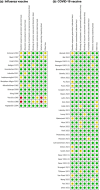Outcomes of vaccinations against respiratory diseases in patients with end-stage renal disease undergoing hemodialysis: A systematic review and meta-analysis
- PMID: 36757979
- PMCID: PMC9910685
- DOI: 10.1371/journal.pone.0281160
Outcomes of vaccinations against respiratory diseases in patients with end-stage renal disease undergoing hemodialysis: A systematic review and meta-analysis
Abstract
Due to the nature of the disease, end-stage renal disease (ESRD) patients suffer from dysfunction of the adaptive immune system, which leads to a poorer response to vaccination. Accordingly, it is crucial to evaluate the efficacy and safety of management strategies, including vaccinations, which could potentially reduce the risk of respiratory diseases, such as pneumonia, influenza, or COVID-19, and its associated outcomes. We searched PubMed, CENTRAL, ScienceDirect, Scopus, ProQuest, and Google Scholar databases using designated MeSH keywords. The risk of bias was assessed using ROBINS-I. The quality of evidence was assessed using the GRADE (Grading of Recommendations, Assessment, Development, and Evaluation) approach. Relative risk (RR) and 95% confidence interval (CI) were calculated. Heterogeneity was investigated using forest plots and I2 statistics. This systematic review included a total of 48 studies, with 13 studies of influenza (H1N1 and H3N2) vaccination and 35 studies of COVID-19 vaccination. H1N1 vaccination in ESRD patients undergoing hemodialysis induced lower seroconversion rates (RR 0.62, 95% CI: 0.56-0.68, p <0.00001) and lower seroprotection rates (RR 0.76, 95% CI: 0.70-0.83, p <0.00001) compared to controls. H3N2 vaccination in ESRD patients undergoing hemodialysis yielded lower seroconversion rates (RR 0.76, 95% CI: 0.68-0.85, p <0.00001) and lower seroprotection rates (RR 0.84, 95% CI: 0.77-0.90, p <0.00001) compared to controls. Twenty-nine studies demonstrate significantly lower antibody levels in ESRD patients undergoing hemodialysis compared to the controls following COVID-19 vaccination. This review presents evidence of lower seroconversion and seroprotection rates after vaccination against viral respiratory diseases in patients with ESRD undergoing hemodialysis. Since hemodialysis patients are more susceptible to infection and severe disease progression, a weakened yet substantial serological response can be considered adequate to recommend vaccination against respiratory diseases in this population. Vaccination dose, schedule, or strategy adjustments should be considered in stable ESRD patients on maintenance hemodialysis. Trial registration: Systematic review registration: https://www.crd.york.ac.uk/prospero/display_record.php?ID=CRD42021255983, identifier: CRD42021255983.
Copyright: © 2023 Puspitasari et al. This is an open access article distributed under the terms of the Creative Commons Attribution License, which permits unrestricted use, distribution, and reproduction in any medium, provided the original author and source are credited.
Conflict of interest statement
The authors have declared that no competing interests exist.
Figures





References
Publication types
MeSH terms
Substances
LinkOut - more resources
Full Text Sources
Medical

